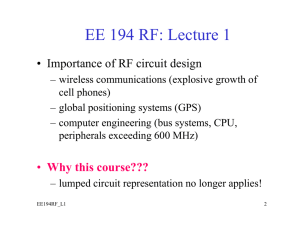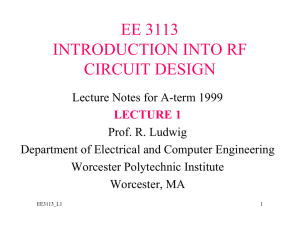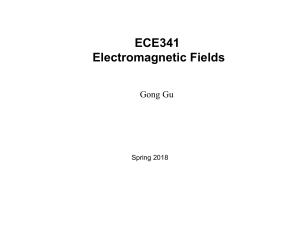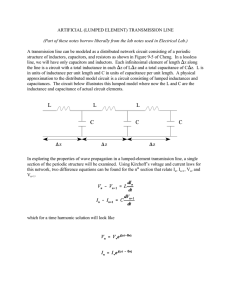ECE341 Electromagnetic Fields Gong Gu
advertisement
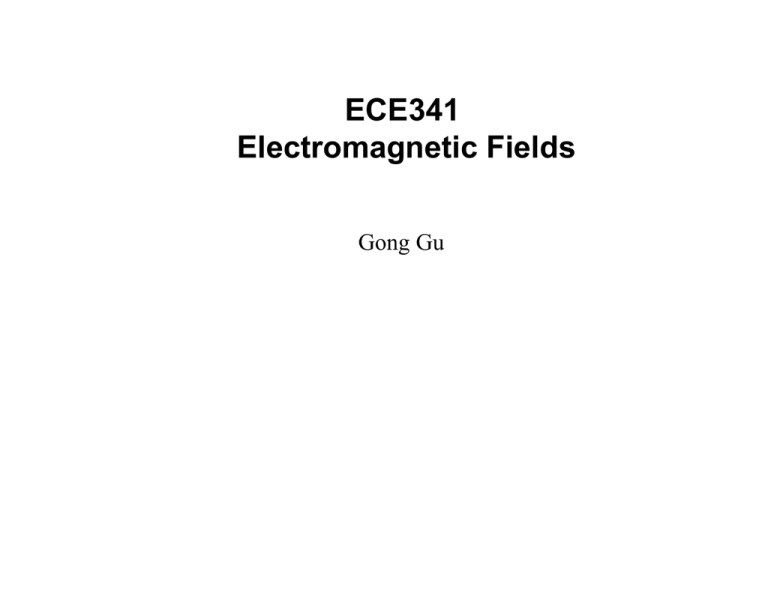
ECE341 Electromagnetic Fields Gong Gu Introduction: Why EM Fields? The electromagnetic force is one of the four fundamental forces of Nature. (What are the other three?) Charged particles interact by the EM force, via EM fields. But why do we (electrical engineers) care? Circuit theory is a simple part of EM (black boxes: lumped components) Inside the black boxes: J = enE V E, J = E = IA Velocity Force? What about Newton’s laws? Q Cv = CEd dv/dt dQ/dt i Bi di/dt dB/dt E v Changing B field induces E I = V/R i = C dv/dt v = L di/dt “Lumped” components when dimensions << wavelength Simplest example: a pair of wires (the term “transmission line” is a bit confusing) Length << Changing electric field induces magnetic field, changing mag. field induces electric field. Therefore waves. Length ~ Current along a wire can vary! A pair of metal sheets can be a waveguide! f Comments 60 Hz 5000 km Power 600 kHz 500 m Medium wave AM radio 0.3 GHz 1m 1.5 GHz 20 cm CPU clock rate 30 GHz 1 cm Data communication 300 GHz 1 mm f = c, c = 3 × 108 m/s microwave This course is about electromagnetics (EM), the electrical foundation of Electrical and Computer Engineering, or, how electricity really works. -- Look into the black boxes. • Circuit theory is a simple part of EM, so it was taught first. • However there are an increasing number of cases in ECE where circuit theory fails (e.g. faster computers, higher communications frequencies, power electronics, power system transients,), and EM must supplement circuit theory. But, don’t worry… • Also EM is the basis for many devices (machinery, antennas, etc.), and one of the physical foundations of any active electronic device. • Serious hazards for electrical and computer engineers in all areas, such as interference and non-ideal behavior of circuit elements, are increasing with the higher frequencies today for Electrical and Computer Engineers in all areas. Read this introduction again at the end of the semester after we have presented all the material. You will have a deeper understanding and a delight from it. Textbook: Ulaby et al, Fundamentals of Applied Electromagnetics (7/E or 6/E) Recommended reference book: Ramo et al, Fields and Waves in Communication Electronics Homework To be finished at the start of class on certain days, indicated in the schedule Tests Partially reflect homework and are certification that you learned what you should from the homework and study. There will be two major tests, on the days indicated in the schedule. Lab (2 or 3 TBD) Completion of all labs is required for course completion Grade (Subject to change due to uncertainty in Lab) Test 1: 25%; Test 2: 25%; Lab: 15%; Final exam: 35% Schedule The syllabus is online, as well as this introduction presentation. The schedule is subject to changes, so check it often. Website http://web.eecs.utk.edu/~ggu1/files/UGHome.html Extra project for Honors class ECE347 Tips How to do well in this course (and others) and prepare to be a successful engineer: • Don't overload your schedule with courses and/or work; • Aim toward becoming a good engineer; • Don't miss classes; • See lab as an inquiry - not following a cook book; • Study daily, not just the four nights before tests; • Ask questions, take notes; • Don't rely on somebody else (or my answer sheets online) for homework. • Pursue understanding of the principles - not just memorizing the symbols in some homework problems and equations; • Try to visualize phenomena - don't just manipulate math symbols; • Relate this material to other courses. • Revisit and reinforce the above three during the course, and, in your future study (e.g. read this Introductions again at end of course). • Read ahead, think in practical terms; see if using the book's CD helps.
